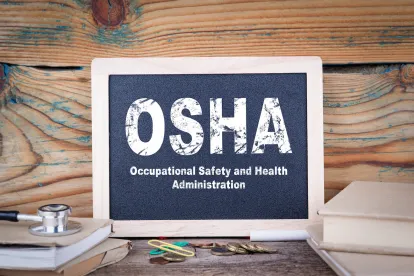On June 17, 2020, the federal Occupational Safety and Health Administration (“OSHA”) issued its “Guidance on Returning to Work.” This new guidance is intended to supplement the previous “Guidance on Preparing Workplaces for COVID-19” that OSHA published in March. Most non-essential businesses throughout the country have already reopened and returned at least some portion of their workforce to the workplace. However, with the risk of occupational exposure to COVID-19 still present, employers must continue to monitor and follow new and evolving federal, state, and local guidance aimed at protecting the safety and health of employees. OSHA’s new guidance contains “guiding principles” that OSHA recommends employers incorporate into their reopening plans. In addition, the new guidance provides OSHA’s responses to frequently asked questions on testing and screening employees and identifies specific OSHA standards and requirements that are applicable to minimizing occupational exposure to COVID-19. Because much of the new guidance deals with mitigation measures that many employers have already implemented, this article seeks to assist employers with understanding specific directives and concerns in the guidance that are new or may have been overlooked previously.
Guiding Principles for Reopening Plans
In discussing employer plans for reopening, the guidance generally instructs employers to reopen in accordance with the three distinct phases contained in the White House’s Guidelines for Opening Up America Again. Most employers are currently in Phase 1, which involves following strict social distancing practices and permitting telework where feasible so as to limit the number of employees in the workplace. Phase 1 also includes limiting non-essential business travel and making accommodations, where feasible, for workers with a higher risk of severe illness, such as individuals over the age of 65 or with serious underlying health conditions. Under Phase 2, employers should continue to accommodate vulnerable workers and permit telework where feasible. However, employers in Phase 2 may allow non-essential business travel to resume and ease limitations on the number of employees in the workplace while continuing to maintain moderate to strict social distancing practices. Finally, businesses in the last phase, Phase 3, may resume unrestricted staffing of work sites. Changing outbreak conditions or a resurgence in the community may force employers to modify specific infection control measures or even backtrack to a prior phase.
Based on evolving outbreak conditions, OSHA instructs that employers’ reopening plans address and include the following non-exhaustive list of guiding principles: hazard assessment, basic hygiene, social distancing, identification and isolation of sick employees, returning recovered or exposed workers, workplace controls and flexibilities, training, and anti-retaliation. Most employers are already familiar with these principles from prior guidance issued by OSHA and the Centers for Disease Prevention and Control (“CDC”). Nevertheless, reviewing the new guidance ensures current infection prevention and control measures are sufficient.
COVID-19 Hazard Assessments
Employers should pay special attention to OSHA’s recommendation that all employers perform a COVID-19 hazard assessment (in fact, California’s Division of Occupational Safety and Health requires that this occur). A hazard assessment requires employers to determine when, where, how, and to what sources of COVID-19 workers are likely to be exposed during the course of their job duties. The assessment should take into account all job tasks performed by the company’s employees and identify particular tasks or job categories that involve occupational exposure to COVID-19. The risk of occupational exposure should include not only exposure from coworkers through close contact or shared spaces/surfaces, but also exposure from the public (e.g., customers, visitors, vendors). Following the assessment, employers can determine specific engineering/administrative controls, safe work practices, and/or personal protective equipment (“PPE”) to utilize to mitigate the risk of exposure for each job task or category. Employers may also need to perform a new assessment as additional workers return to the workplace, thereby potentially decreasing the effectiveness of previous measures and increasing the risk of exposure.
OSHA’s Responses to Frequently Asked Questions
The new guidance includes OSHA’s responses to some frequently asked questions, including questions on testing and screening that have been answered previously by the Equal Employment Opportunity Commission (“EEOC”). The responses below summarize OSHA’s position and identify additional, relevant information that may be of interest to employers.
Q: Can employers conduct work site COVID-19 testing?
A: Yes, neither the Occupational Safety and Health Act (“OSH Act”) nor OSHA standards prohibit employers testing for COVID-19, if applied in a transparent manner applicable to all employees (i.e., non-retaliatory). However, OSHA advises employers to act cautiously on negative test results because of the limitations of current testing capabilities. Furthermore, the EEOC also issued guidance on June 17, 2020, prohibiting the administration of COVID-19 antibody tests (also called “serologic tests”) because they violate the Americans with Disabilities Act (“ADA”). For more information on the EEOC’s recent guidance on testing, employers should consult the article available here.
Q: Can employers conduct work site temperature checks or other health screening?
A: Yes, neither the OSH Act nor OSHA standards prohibit employers screening for COVID-19, if applied in a transparent manner applicable to all employees. Additionally, the guidance advises that while temperature screening can be part of a comprehensive program to monitor employee health, screening has limited utility on its own because people with COVID-19 can spread the virus even if they do not exhibit symptoms like a high temperature. OSHA also recommends that temperature screening conducted at home by employees is likely to be more beneficial than screenings at work, especially when utilized in conjunction with sick leave policies that encourage sick workers to stay at home. For additional guidance on performing temperature checks on employees, employers should consult the article available here.
Q: What OSHA requirements must an employer follow when conducting health screening, temperature checking, or COVID-19 testing?
A: For employers who create written or electronic records of the information obtained through health screenings or temperature checks, OSHA advises that those records may qualify as medical records under OSHA’s Access to Employee Exposure and Medical Records (“AEEMR”) standard (29 C.F.R. § 1910.1020). Under the AEEMR standard, employers are required to retain medical records for the duration of the worker’s employment plus 30 years while also maintaining confidentiality as required by the ADA. As an alternative, OSHA advises that employers do not need to make a record of temperatures and can instead simply acknowledge a temperature reading in real-time. The guidance also clarifies that temperature records do not qualify as medical records under the AEEMR standard unless they are made or maintained by a physician, nurse, or other health care personnel or technician. Consequently, documentation of an employee’s results from COVID-19 viral testing administered by health care personnel or technicians presumably falls under the AEEMR standard. OSHA also advises that any personnel administering screenings, temperature checks, or testing, must be sufficiently protected from exposure through appropriate engineering and administrative controls, safe work practices, and PPE.
Q: How do I know if employees need PPE?
A: OSHA advises that employers must conduct a hazard assessment in accordance with OSHA’s PPE standard (29 C.F.R. § 1910.132), if applicable, to determine any appropriate PPE required for their specific work site. Through the hazard assessment, employers must determine whether PPE (such as gloves, surgical masks, and face shields) are necessary because engineering or administrative controls and safe work practices, including social distancing or the use of face coverings, cannot effectively mitigate employees’ risk of COVID-19 exposure. The guidance advises that if PPE is needed for a work task, but not available, and employers cannot identify alternative means to accomplish the task safely, the task must be discontinued. The guidance also clarifies that cloth face coverings are not PPE, and requirements to wear cloth face coverings constitute an administrative control. Employers who are confused about the differences between cloth face coverings, surgical masks, and respirators should consult OSHA’s mask FAQ web page.
Applicable OSHA Standards and Requirements
Appendix A of the guidance identifies specific OSHA standards that may be relevant to employers reopening, including the AEEMR and PPE standards mentioned above, and how those standards apply to preventing potential exposure, hazard assessments, implementation programs, workplace controls, housekeeping, training, recordkeeping, and prohibitions on retaliation. Employers should review Appendix A and the underlying OSHA standards, or the standards under any OSHA-approved state plans, to ensure they are compliant.
Main Takeaways from New OSHA Guidance
Like OSHA’s previous guidance on preparing the workplace for dealing with COVID-19, the new guidance on returning to work does not constitute a standard or regulation and therefore does not create any new legal obligations. Instead, the guidance is intended to assist employers on providing a safe and healthful workplace. OSHA’s General Duty Clause does require employers to provide employees with a workplace free from recognized hazards likely to cause death or serious physical harm, including exposure to COVID-19. Accordingly, savvy employers would be wise to review the recommendations contained in the new guidance and ensure they do the following:
- Perform and document a COVID-19 hazard assessment if the employer has not done so already.
- Continue to monitor any federal, state, local, or industry-specific COVID-19 guidance and update the infection prevention and control measures in the employer’s COVID-19 response and action plan accordingly.
- Identify control measures that can be relaxed as the employer progresses into later phases of reopening and the metrics for when relaxation or reinstatement of control measures should occur.
- Review and determine how OSHA and state OSHA standards and requirements apply to the employer’s workplace, such as whether the AEEMR standard applies if the employer conducts health screenings or testing of employees.
Employers with any questions or concerns about performing the above should consult with experienced OSHA counsel to ensure they are satisfying all of the increased safety and health obligations and complications brought on by the pandemic.
As you are aware, things are changing quickly and there is a lack of clear-cut authority or bright line rules on implementation. This article is not intended to be an unequivocal, one-size fits all guidance, but instead represents our interpretation of where things currently and generally stand. This article does not address the potential impacts of the numerous other local, state and federal orders that have been issued in response to the COVID-19 pandemic, including, without limitation, potential liability should an employee become ill, requirements regarding family leave, sick pay and other issues.




 />i
/>i


